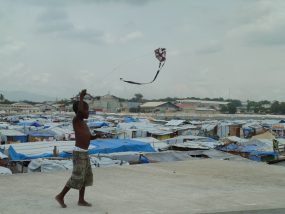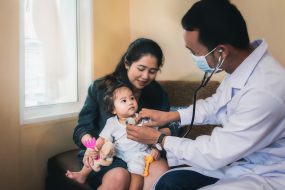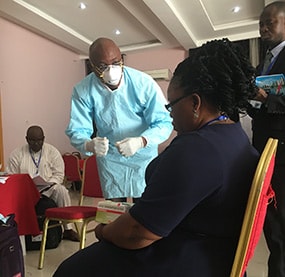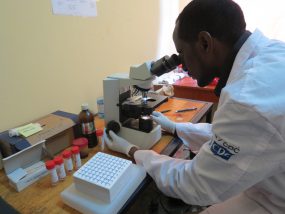Immigrant and Refugee Health Branch
Who We Are

CDC’s Division of Global Migration Health (DGMH) focuses on activities that lessen the public health risks of rapid global travel because diseases and outbreaks can quickly cross international borders. The Immigrant and Refugee Health Branch (IRHB), within DGMH, partners with agencies, governments, and organizations to strengthen health systems at country borders and promotes and improves the health of immigrants, US-bound refugees, and migrants.
What We Do
IRHB prevents the importation of infectious diseases by safeguarding the health of US-bound immigrant and refugee populations. IRHB achieves this by:
- Tracking and responding to disease outbreaks
- in refugee populations overseas and in the United States
- in host countries when the outbreak may cross an international border
- Developing Technical Instructions and training healthcare providers who perform mandatory overseas pre-departure medical exams to ensure that health conditions are documented and treated as required
- Overseeing the required medical examination of refugee and immigrant visa applicants before they travel to the United States
- Promoting, monitoring, and improving the health of children adopted outside of the United States
- Educating immigrant and refugee groups and partners about disease prevention and good health practices
- Coordinating with domestic health departments, foreign health agencies, and nongovernmental organizations to develop, implement, and evaluate programs that improve health outcomes in globally mobile populations
- Partnering with other governments to provide technical assistance at points of entry, along informal cross-border movement, and for cross-border collaboration building to strengthen surveillance, preparedness, and response among mobile populations
- Promoting preventive treatments for and vaccination of refugees and immigrants before departure for several communicable diseases
- Providing technical assistance and training to regional medical and public health officials allowing them to identify, treat, and track diseases that threaten the health of refugees, immigrants, and US residents
Where We Work

IRHB promotes and improves the health of immigrants, US-bound refugees, and migrants, as well as any mobile and cross-border population, through domestic and overseas programs. Domestically, IRHB collaborates with state and local health departments to improve the healthcare and monitoring of medical conditions in these populations after their arrival in the United States. IRHB operates regional field programs in Kenya and Thailand, which oversee work in Africa and Asia, respectively, and participates in active partnerships and projects in more than 50 countries.
How We Work Together
IRMH works with partners in the United States and around the world on a variety of initiatives to address public health needs associated with population mobility.

Stateside partners, including the Department of Health and Human Services Office of Refugee Resettlement, state and local health departments, refugee resettlement agencies, and the Association of Refugee Health Coordinators, monitor the health of refugee populations after their arrival in the US.
Internationally, IRHB partners with the World Health Organization; the United Nations Refugee Agency; the US State Department Bureau of Population, Refugees and Migration; the International Organization for Migration; country governments; and more than 30 other organizations, such as customs, immigration, and security agencies. Some of these partners help IRHB conduct the mandatory overseas medical examinations, transmit examination records to partner agencies and organizations in the United States, and connect mobile populations with domestic resources to ensure a continuum of care.
IRHB’s international partners also help implement technical support to governments around the world. Some partners work with IRHB at points of entry, including international airports, ports of entry, ground crossings, and in border areas. These partnerships are key for training and adaptation of border health tools, supporting the implementation of methods, and interpreting information about population movement and the spread of disease among internationally mobile populations.
Program in Action

Tracking and Responding to Outbreaks
- Participate in CDC response efforts with partner countries during outbreaks of international concern to mitigate the international spread of disease
- Track disease outbreaks to improve understanding of the epidemiology of diseases of concern in immigrants and refugees, including tuberculosis and vaccine-preventable diseases
- Support initiatives to map and analyze mobility and social connectivity trends among internationally mobile populations
- Develop guidelines to respond to disease outbreaks and other health events affecting US-bound immigrants and refugees.
- Build capacity for healthcare partners and strengthen international partnerships at points of entry towards International Health Regulations goals
Pre-departure Medical Screening and Treatment Programs:
- Develop Technical Instructions, train overseas physicians, and ensure the quality of medical screening and laboratory diagnostics for US-bound refugees and immigrants, including children adopted overseas
- Oversee the Vaccination Program for US-bound Refugees and the Presumptive Treatment Program for malaria and intestinal parasites
Post-arrival US Medical Follow-Up:
- Develop guidelines related to refugee populations for domestic healthcare providers, ensuring continuity of care upon refugees’ arrival to the United States
- Manage the Electronic Disease Notification system for sharing overseas examination records of immigrants and refugees with state and local health departments for post-arrival follow-up
- Visit the Immigrant and Refugee Health Branch site.
- Read Immigrant and Refugee Health feature stories: